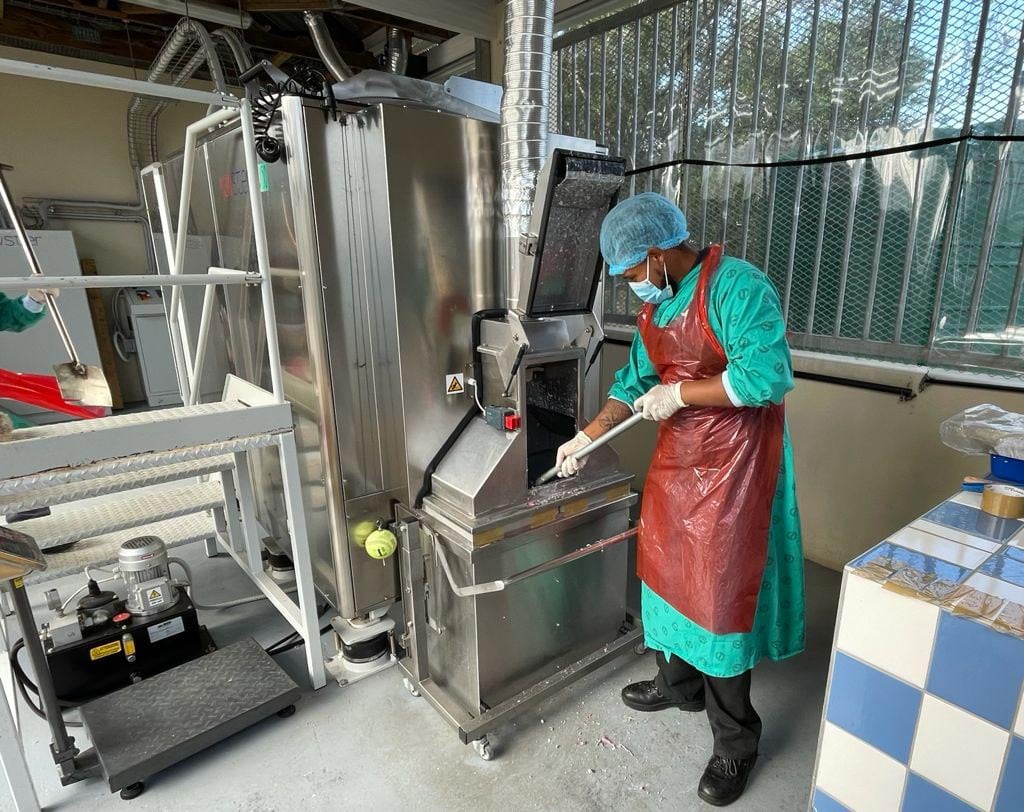The treatment and disposal of Health Care Risk Waste (HCRW) was a problem to be solved for the George Hospital in George South Africa.
Located in the rural Garden Route District, the hospital had to make a trip of 450 kilometres five times a week to transport infectious waste for processing to a Cape Town medical waste treatment plant. This was not only burdensome, but also generated a significant carbon footprint. The sharps waste also needed to be incinerated with a consequential environmental impact.
Faced with this problem, Michael Vonk, the George Hospital’s Chief Executive Officer, and his team decided to apply the Proximity Principle of Waste Management by procuring and installing medical waste treatment equipment on-site to deal with hospital infectious waste at the point of generation. The new equipment allowed for the mechanical destruction of the waste by using sterilising heat.

Health care waste treatment operators: Bjorn Paulse emptying the waste treatment machine at the end of a cycle.
2021 © Michael Vonk
For Mr. Vonk, the on-site treatment of HCRW is “one more method for hospital staff to take meaningful action to reduce their impact on the environment and work towards achieving a sustainable future.” The task ahead was huge. But the benefits would also be great. Ensuring environmental responsibility was front and centre during the entire process. “To be a leader in environmentally responsible health care is one of our strategic priorities,” Vonk adds.

There is an urgent call to action for hospitals to move away from medical waste incinerators and engage in sustainable models of waste disposal.
Prior to his position at George Hospital, Michael Vonk worked for ten years for the National Health System (NHS) in the United Kingdom.
He’s passionate about the environment, the outdoors, and trail running. He is also a volunteer for the National Sea Rescue Institute (NSRI).
After selecting and sourcing the right equipment with support from the Western Cape Government, Vonk and his team worked on developing the protocols and procedures so that they were specifically tailored to George Hospital’s needs and the type of waste produced. The results met and exceeded their expectations. The chemical and microbiological analysis determined that following treatment, the HCRW is no longer classified as hazardous and can be disposed of in a local landfill located at a distance of 60 kilometres. Waste is currently only transported to the site every two weeks.
For staff at George Hospital, this process has the added benefit of raising awareness about waste management, encouraging ownership of the problem, as well as to promote action at the local level and within communities.
“This model has elicited great interest from other regional hospitals, which are also implementing this technology,” says Vonk. “There is an urgent call to action for hospitals to move away from medical waste incinerators and engage in sustainable models of waste disposal by procuring on-site treatment methods similar to this one. This will save on costs and will be more environmentally friendly.”
In addition to reducing the environmental cost of operations, this new treatment facility has allowed for the safe treatment of COVID-19 waste on-site rather than incinerating it as was previously the case.
“This is a safer procedure for staff and communities,” explains Vonk. “Waste is turned into homogenous granules which eliminate sharps or cutting objects. Among other benefits, there’s no risk for staff of contamination during transportation.”
“Transporting waste has environmental, social, and economic costs, says Vonk. “As a general rule, waste should be dealt with as close to the place of generation as possible.”
George Hospital is planning to work with local clinics and nearby hospitals to process their waste to prevent the need for it to be transported for disposal.
“As a public health facility, it is important to our patients and the community that we serve that we promote public health and community resilience in its widest sense. Transitioning towards a more sustainable and resilient health care facility and minimising the negative impacts on the environment is a goal that many staff identify with,” Vonk says. He adds that: “As a leader, I believe that I have the responsibility to take action to demonstrate accountability and make real changes towards achieving net-zero emissions. Through our actions, we can mobilise and inspire other leaders to take meaningful steps and work collectively to resolve health system challenges.”
75% reduction of the initial waste volume
by treating infectious waste using the George Hospital method.
45% reduction of monthly operational costs
by treating infectious waste using the George Hospital method.
99% reduction of transport emissions and carbon footprint
by treating infectious waste on-site at the George Hospital.






